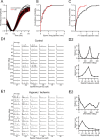Neonatal cerebral hypoxia-ischemia impairs plasticity in rat visual cortex
- PMID: 20053890
- PMCID: PMC2822440
- DOI: 10.1523/JNEUROSCI.5656-08.2010
Neonatal cerebral hypoxia-ischemia impairs plasticity in rat visual cortex
Abstract
Ocular dominance plasticity (ODP) following monocular deprivation (MD) is a model of activity-dependent neural plasticity that is restricted to an early critical period regulated by maturation of inhibition. Unique developmental plasticity mechanisms may improve outcomes following early brain injury. Our objective was to determine the effects of neonatal cerebral hypoxia-ischemia (HI) on ODP. The rationale extends from observations that neonatal HI results in death of subplate neurons, a transient population known to influence development of inhibition. In rodents subjected to neonatal HI and controls, maps of visual response were derived from optical imaging during the critical period for ODP and changes in the balance of eye-specific response following MD were measured. In controls, MD results in a shift of the ocular dominance index (ODI) from a baseline of 0.15 to -0.10 (p < 0.001). Neonatal HI with moderate cortical injury impairs this shift, ODI = 0.14 (p < 0.01). Plasticity was intact in animals with mild injury and in those exposed to hypoxia alone. Neonatal HI resulted in decreased parvalbumin expression in hemispheres receiving HI compared with hypoxia alone: 23.4 versus 35.0 cells/high-power field (p = 0.01), with no change in other markers of inhibitory or excitatory neurons. Despite abnormal inhibitory neuron phenotype, spontaneous activity of single units and development of orientation selective responses were intact following neonatal HI, while overall visual responses were reduced. Our data suggest that specific plasticity mechanisms are impaired following early brain injury and that the impairment is associated with altered inhibitory neuronal development and cortical activation.
Figures







Similar articles
-
Unbiased Quantification of Subplate Neuron Loss following Neonatal Hypoxia-Ischemia in a Rat Model.Dev Neurosci. 2017;39(1-4):171-181. doi: 10.1159/000460815. Epub 2017 Apr 22. Dev Neurosci. 2017. PMID: 28434006 Free PMC article.
-
Reduced Cortical Activity Impairs Development and Plasticity after Neonatal Hypoxia Ischemia.J Neurosci. 2015 Aug 26;35(34):11946-59. doi: 10.1523/JNEUROSCI.2682-14.2015. J Neurosci. 2015. PMID: 26311776 Free PMC article.
-
A disinhibitory microcircuit initiates critical-period plasticity in the visual cortex.Nature. 2013 Sep 26;501(7468):543-6. doi: 10.1038/nature12485. Epub 2013 Aug 25. Nature. 2013. PMID: 23975100 Free PMC article.
-
Plasticity in the Neonatal Brain following Hypoxic-Ischaemic Injury.Neural Plast. 2016;2016:4901014. doi: 10.1155/2016/4901014. Epub 2016 Mar 7. Neural Plast. 2016. PMID: 27047695 Free PMC article. Review.
-
Development of ocular dominance columns across rodents and other species: revisiting the concept of critical period plasticity.Front Neural Circuits. 2024 Jul 5;18:1402700. doi: 10.3389/fncir.2024.1402700. eCollection 2024. Front Neural Circuits. 2024. PMID: 39036421 Free PMC article. Review.
Cited by
-
Effects of Three Different Doses of Inter-Alpha Inhibitor Proteins on Severe Hypoxia-Ischemia-Related Brain Injury in Neonatal Rats.Int J Mol Sci. 2022 Nov 3;23(21):13473. doi: 10.3390/ijms232113473. Int J Mol Sci. 2022. PMID: 36362257 Free PMC article.
-
Cardiac Arrest-Induced Global Brain Hypoxia-Ischemia during Development Affects Spontaneous Activity Organization in Rat Sensory and Motor Thalamocortical Circuits during Adulthood.Front Neural Circuits. 2016 Aug 25;10:68. doi: 10.3389/fncir.2016.00068. eCollection 2016. Front Neural Circuits. 2016. PMID: 27610077 Free PMC article.
-
Neonatal Ethanol Disturbs the Normal Maturation of Parvalbumin Interneurons Surrounded by Subsets of Perineuronal Nets in the Cerebral Cortex: Partial Reversal by Lithium.Cereb Cortex. 2019 Apr 1;29(4):1383-1397. doi: 10.1093/cercor/bhy034. Cereb Cortex. 2019. PMID: 29462278 Free PMC article.
-
The Integrative Function of Silent Synapses on Subplate Neurons in Cortical Development and Dysfunction.Front Neuroanat. 2019 Apr 16;13:41. doi: 10.3389/fnana.2019.00041. eCollection 2019. Front Neuroanat. 2019. PMID: 31040772 Free PMC article. Review.
-
Global impairment and therapeutic restoration of visual plasticity mechanisms after a localized cortical stroke.Proc Natl Acad Sci U S A. 2011 Sep 13;108(37):15450-5. doi: 10.1073/pnas.1016458108. Epub 2011 Aug 24. Proc Natl Acad Sci U S A. 2011. PMID: 21873250 Free PMC article.
References
-
- Akerman CJ, Cline HT. Refining the roles of GABAergic signaling during neural circuit formation. Trends Neurosci. 2007;30:382–389. - PubMed
-
- Allendoerfer KL, Shatz CJ. The subplate, a transient neocortical structure: its role in the development of connections between thalamus and cortex. Annu Rev Neurosci. 1994;17:185–218. - PubMed
-
- Alpár A, Gärtner U, Härtig W, Brückner G. Distribution of pyramidal cells associated with perineuronal nets in the neocortex of rat. Brain Res. 2006;1120:13–22. - PubMed
-
- Arumugam H, Liu X, Colombo PJ, Corriveau RA, Belousov AB. NMDA receptors regulate developmental gap junction uncoupling via CREB signaling. Nat Neurosci. 2005;8:1720–1726. - PubMed
Publication types
MeSH terms
Grants and funding
LinkOut - more resources
Full Text Sources
